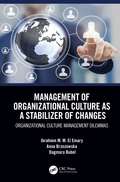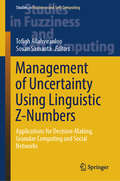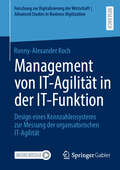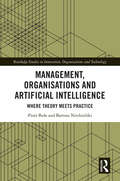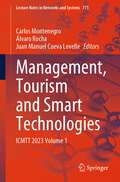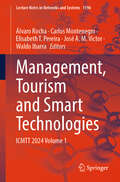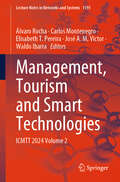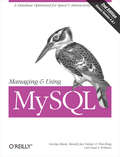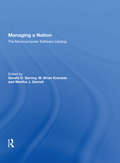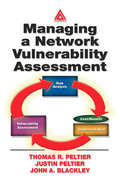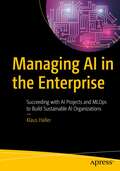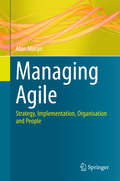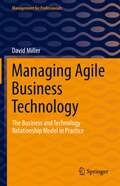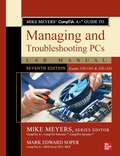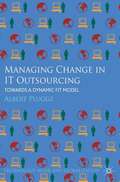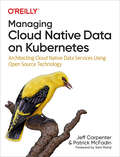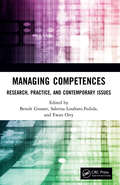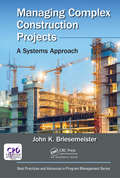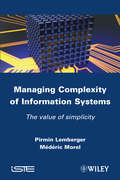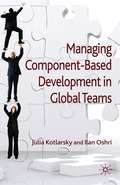- Table View
- List View
Management of Organizational Culture as a Stabilizer of Changes: Organizational Culture Management Dilemmas
by Ibrahiem M. El Emary Anna Brzozowska Dagmara BubelNo enterprise today is proud of being unchanged. Stability is understood more as a sign of stagnation than reliability, and enterprises that do not change and do not evolve are commonly regarded as fossilized. Increasing globalization processes often force today’s enterprises to make organizational changes, but the effectiveness of these processes relies on its organizational culture. This book argues that the problem behind organizational culture is its multilevel structure, including the visible and hidden levels. It addresses difficult questions, such as: Is it better to make thorough, but more painful changes, or to gradually introduce small improvements? It also demonstrates that organizational culture is not a fixed phenomenon: its shaping takes place in stages, and it is essential to take such stages into account in the process of implementing the strategy of an enterprise. Providing a comprehensive insight into "organizational culture" and its relationship to change, this book will be essential reading for professionals involved in business management and IT management throughout the world. Its analyses and suggestions will allow for improved organizational culture and change management in business environments.
Management of Uncertainty Using Linguistic Z-Numbers: Applications for Decision-Making, Granular Computing and Social Networks (Studies in Fuzziness and Soft Computing #434)
by Tofigh Allahviranloo Sovan SamantaThis book is an in-depth study of the application of Linguistic Z numbers in various domains. It is divided into 18 chapters, each focusing on different aspects and applications of Linguistic Z numbers. The first chapter introduces the concept of a Linguistic Z number fuzzy probabilistic rough set and their corresponding three-way decisions. The second chapter discusses the TOPSIS-based multi-attribute group decision-making (MAGDM) under Linguistic Z number information. The third chapter presents a new approach of multi-criteria group decision-making (MCGDM): MARCOS-based alternatives measurement with ranking under Linguistic Z number information and their application in the selection of logistics distribution cold chain center. The fourth chapter focuses on the Linguistic Z number environment-based site selection of medical logistic centers with the TODIM-VIKOR approach. The fifth chapter explores MCGDM based on TODIM-PROMETHEE II under Linguistic Z number environment and their application in site selection of emergency shelters. The sixth chapter introduces a novel approach of extended ORESTE-based Linguistic Z number MAGDM and their applications in the ability of regional energy assessment. The seventh chapter discusses MCGDM based on MULTIMOORA with Linguistic Z number and their application in software selection. The eighth chapter presents multi-criteria group decision-making using the LogTODIM-TOPSIS approach in a Linguistic Z number environment for selecting auto parts materials in the technology of automobiles. The ninth chapter introduces a Linguistic Z number CoCoSo approach for multi-criteria group decision-making and application to the diagnosis of sepsis. The tenth chapter discusses The ExpTODIM-VIKOR approach under a Linguistic Z number environment and its applications to solve multi-criteria group decision-making problems. This book provides a deep understanding of Linguistic Z numbers and their applications in decision-making, granular computing, and social networks. It is a valuable resource for researchers and practitioners in these fields.
Management von IT-Agilität in der IT-Funktion: Design eines Kennzahlensystems zur Messung der organsatorischen IT-Agilität (Forschung zur Digitalisierung der Wirtschaft | Advanced Studies in Business Digitization)
by Ronny-Alexander KochRonny-Alexander Koch konzentriert sich in seiner Forschung auf die IT-Agilität im organisatorischen Handlungsfeld und berücksichtigt die Aufbau- und die Ablauforganisation der IT-Funktion. Unter Anwendung der Design-Science manifestiert sich ein Artefakt in Form eines Kennzahlensystems auf Basis eines interdisziplinären Literaturreviews. Das Kennzahlensystem erfährt eine iterative Evaluation und Optimierung auf Basis einer mixed-mode Delphi-Studie und instrumentellen Fallstudien in Unternehmen verschiedener Branchen. Der gemessene organisatorische IT-Agilitätsindex offenbart signifikante Unterschiede und Verbesserungspotenziale. Das entwickelte Artefakt ermöglicht es nun erstmals dem oberen Führungskreis der IT-Funktion, die organisatorische IT-Agilität eigenständig zu messen, zu vergleichen und auf dieser Grundlage praktische Maßnahmen zur Steuerung der IT-Agilität zu ergreifen.
Management, Organisations and Artificial Intelligence: Where Theory Meets Practice (Routledge Studies in Innovation, Organizations and Technology)
by Piotr Buła Bartosz NiedzielskiThis book combines academic research with practical guidelines in methods and techniques to supplement existing knowledge relating to organizational management in the era of digital acceleration. It offers a simple layout with concise but rich content presented in an engaging, accessible style and the authors’ holistic approach is unique in the field. From a universalist perspective, the book examines and analyzes the development of, among others, Industry 4.0, artificial intelligence (AI), AI 2.0, AI systems and platforms, algorithmics, new paradigms of organization management, business ecosystems, data processing models in AI-based organizations and AI strategies in the global perspective. An additional strength of the book is its relevance and contemporary nature, featuring information, data, forecasts or scenarios reaching up to 2030. How does one build, step by step, an organization that will be based on artificial intelligence technology and gain measurable benefits from it, for instance, as a result of its involvement in the creation of the so-called mesh ecosystem? The answer to this and many other pertinent questions are provided in this book. This timely and important book will appeal to scholars and students across the fields of organizational management and innovation and technology management, as well as managers, educators, scientists, entrepreneurs, innovators and more.
Management, Tourism and Smart Technologies: ICMTT 2023 Volume 1 (Lecture Notes in Networks and Systems #773)
by Álvaro Rocha Carlos Montenegro Juan Manuel Cueva LovelleThis book presents advances in the research of various entities in the world, which are working on the application of technology or management in tourism. Indeed, one of the sectors hardest hit by the pandemic was tourism, likewise one of the post-pandemic effects is the rapid recovery of the sector, but more importantly is the great innovation that has occurred in marketing strategies for tourism using technology and applying management strategies not only to be more profitable but to have the best customer satisfaction. The book is aimed at the general public that seeks to innovate, learn from lessons learned and establish a knowledge base in mechanisms that apply technology or management in tourism, with the aim of improving the experience of all those involved in the business chain.This compendium aims to share all those great experiences and researches in the areas of: Managements, Tourism, Marketing strategies in Management, Tourism and Technology, Technology, Applied Computer Science, Artificial Intelligence, Business Administration, Cloud Computing, Educational Management, Finance, Insurance and Services Management, Health Tourism, Human Resource Management, Information Systems Planning and Management, Information Technologies in Tourism, Internet Technology, Knowledge Management, Management of Supply Chain and Logistics, Marketing Innovation, Robotics, Strategic Management Innovation, Sustainability Management, Technical Economy Management, Technical Innovation and Management, Technology in Tourism and Tourist Experience, Tourism Industry and Ecology, Tourism Management, a total of 77 research projects and many spaces and relationships between researchers to collaborate in the advancement of science are presented.
Management, Tourism and Smart Technologies: ICMTT 2023 Volume 2 (Lecture Notes in Networks and Systems #774)
by Álvaro Rocha Carlos Montenegro Juan Manuel Cueva LovelleThis book presents advances in the research of various entities in the world, which are working on the application of technology or management in tourism. Indeed, one of the sectors hardest hit by the pandemic was tourism, likewise one of the post-pandemic effects is the rapid recovery of the sector, but more importantly is the great innovation that has occurred in marketing strategies for tourism using technology and applying management strategies not only to be more profitable but to have the best customer satisfaction. The book is aimed at the general public that seeks to innovate, learn from lessons learned and establish a knowledge base in mechanisms that apply technology or management in tourism, with the aim of improving the experience of all those involved in the business chain.This compendium aims to share all those great experiences and researches in the areas of: Managements, Tourism, Marketing strategies in Management, Tourism and Technology, Technology, Applied Computer Science, Artificial Intelligence, Business Administration, Cloud Computing, Educational Management, Finance, Insurance and Services Management, Health Tourism, Human Resource Management, Information Systems Planning and Management, Information Technologies in Tourism, Internet Technology, Knowledge Management, Management of Supply Chain and Logistics, Marketing Innovation, Robotics, Strategic Management Innovation, Sustainability Management, Technical Economy Management, Technical Innovation and Management, Technology in Tourism and Tourist Experience, Tourism Industry and Ecology, Tourism Management, a total of 77 research projects and many spaces and relationships between researchers to collaborate in the advancement of science are presented.
Management, Tourism and Smart Technologies: ICMTT 2024 Volume 1 (Lecture Notes in Networks and Systems #1190)
by Álvaro Rocha Elisabeth T. Pereira Carlos Montenegro Waldo Ibarra José A. M. VictorThis book features a selection of articles from the 2024 International Conference on Management, Tourism and Technologies (ICMTT´24), held at the Universidad Nacional de San Antonio Abad del Cusco, in Cusco, Peru, between May 9 and 11, 2024. ICMTT is an international forum for researchers and practitioners to present and discuss the most recent innovations, trends, results, experiences and concerns in the several perspectives of Management, Tourism and Technologies. The main and distinctive areas covered are: Area A – Managements; Area B – Tourism; Area C – Marketing strategies in Management, Tourism and Technology; and Area D – Technology. The primary market of this book is postgraduates and researchers in Management, Tourism and Technologies fields. And the secondary market is undergraduates and professionals as well in management, tourism and technologies fields.
Management, Tourism and Smart Technologies: ICMTT 2024 Volume 2 (Lecture Notes in Networks and Systems #1191)
by Álvaro Rocha Elisabeth T. Pereira Carlos Montenegro Waldo Ibarra José A. M. VictorThis book features a selection of articles from the 2024 International Conference on Management, Tourism and Technologies (ICMTT´24), held at the Universidad Nacional de San Antonio Abad del Cusco, in Cusco, Peru, between May 9 and 11, 2024. ICMTT is an international forum for researchers and practitioners to present and discuss the most recent innovations, trends, results, experiences and concerns in the several perspectives of Management, Tourism and Technologies. The main and distinctive areas covered are: Area A – Managements; Area B – Tourism; Area C – Marketing strategies in Management, Tourism and Technology; and Area D – Technology. The primary market of this book is postgraduates and researchers in Management, Tourism and Technologies fields. And the secondary market is undergraduates and professionals as well in management, tourism and technologies fields.
Managerial Discretion in Imperfect Markets
by T. V. Ramamohan RaoThis book deals with behavioral responses of management of firms that make several decisions with respect to production, marketing, finance, organization of activities within divisions, and interrelations between divisions (including synergies between them and constraints placed on each other in the attainment of overall goals of the firm). The market conditions, that constitute the basis of such decisions, may be stable, random but predictable, or uncertain. It can be expected that objectives attained by the firm, as a result of decisions of management, may be different from the maximum which can be achieved. A generic conceptualization of such managerial discretion and operationally useful methods of measurement have been presented. It is possible to develop machine learning algorithms on this basis to minimize managerial discretion and assist managers in arriving at strategic decisions thereby leaving more resources to deal with uncertain events as they arise. The volume is a great resource not only for researchers, but also decision makers in corporates.
Managing & Using MySQL: Open Source SQL Databases for Managing Information & Web Sites
by George Reese Hugh E. Williams Tim King Randy YargerMySQL is a popular and robust open source database product that supports key subsets of SQL on both Linux and Unix systems. MySQL is free for nonprofit use and costs a small amount for commercial use. Unlike commercial databases, MySQL is affordable and easy to use. This book includes introductions to SQL and to relational database theory. If you plan to use MySQL to build web sites or other Linux or Unix applications, this book teaches you to do that, and it will remain useful as a reference once you understand the basics. Ample tutorial material and examples are included throughout.This book has all you need to take full advantage of this powerful database management system. It takes you through the whole process from installation and configuration to programming interfaces and database administration. This second edition has a greatly enhanced administration chapter that includes information on administrative tools, server configuration, server startup and shutdown, log file management, database backup and restore, and database administration and repair. In addition, a new chapter on security describes data, server, and client-server security, while a chapter on extending MySQL provides an overview of MySQL internals and describes the use of MySQL user-defined functions.If you know C/C++, Java, Perl, PHP, or Python, you can write programs to interact with your MySQL database. In addition, you can embed queries and updates directly in an HTML file so that a web page becomes its own interface to the database. Managing and Using MySQL includes chapters on the programming language interfaces, and it also includes a complete reference section with specific function calls for each language.Also included in the reference section are references to the SQL language, and details of the MySQL system variables, programs, and utilities. New to the second edition is a reference to the internal MySQL tables, which will be of particular interest to those who want to work extensively with MySQL security.
Managing A Nation: The Microcomputer Software Catalog--second Edition
by Richard Harwood David Holland John D. Sterman James W. Mercer Margee M. Ensign Martha J. Garrett Gerald O. Barney W. Brian Kreutzer Stephen J. Binhak Jennie M. Hommel J. G. Krishnayya Lynn A. Kurtz Kenneth L. Kvamme Norman Meyers Peter J. Opdahl Ann Elise Schneider Alan M. Thorndike Daniel Tunstall Sheryl WilkinsThis book is a collection of reviews of microcomputer programs of special relevance to those people around the world who are responsible for the management of the current and future affairs and business of their countries.
Managing A Network Vulnerability Assessment
by Thomas R. Peltier Justin Peltier John A. BlackleyThe instant access that hackers have to the latest tools and techniques demands that companies become more aggressive in defending the security of their networks. Conducting a network vulnerability assessment, a self-induced hack attack, identifies the network components and faults in policies, and procedures that expose a company to the damage caused by malicious network intruders. Managing a Network Vulnerability Assessment provides a formal framework for finding and eliminating network security threats, ensuring that no vulnerabilities are overlooked. This thorough overview focuses on the steps necessary to successfully manage an assessment, including the development of a scope statement, the understanding and proper use of assessment methodology, the creation of an expert assessment team, and the production of a valuable response report. The book also details what commercial, freeware, and shareware tools are available, how they work, and how to use them. By following the procedures outlined in this guide, a company can pinpoint what individual parts of their network need to be hardened, and avoid expensive and unnecessary purchases.
Managing AI in the Enterprise: Succeeding with AI Projects and MLOps to Build Sustainable AI Organizations
by Klaus HallerDelivering AI projects and building an AI organization are two big challenges for enterprises. They determine whether companies succeed or fail in establishing AI and integrating AI into their digital transformation. This book addresses both challenges by bringing together organizational and service design concepts, project management, and testing and quality assurance. It covers crucial, often-overlooked topics such as MLOps, IT risk, security and compliance, and AI ethics. In particular, the book shows how to shape AI projects and the capabilities of an AI line organization in an enterprise. It elaborates critical deliverables and milestones, helping you turn your vision into a corporate reality by efficiently managing and setting goals for data scientists, data engineers, and other IT specialists. For those new to AI or AI in an enterprise setting you will find this book a systematic introduction to the field. You will get the necessary know-how to collaborate with and lead AI specialists and guide them to success. Time-pressured readers will benefit from self-contained sections explaining key topics and providing illustrations for fostering discussions in their next team, project, or management meeting. Reading this book helps you to better sell the business benefits from your AI initiatives and build your skills around scoping and delivering AI projects. You will be better able to work through critical aspects such as quality assurance, security, and ethics when building AI solutions in your organization.What You Will LearnClarify the benefits of your AI initiatives and sell them to senior managersScope and manage AI projects in your organizationSet up quality assurance and testing for AI models and their integration in complex software solutionsShape and manage an AI delivery organization, thereby mastering ML Ops Understand and formulate requirements for the underlying data management infrastructureHandle AI-related IT security, compliance, and risk topics and understand relevant AI ethics aspects Who This Book Is ForExperienced IT managers managing data scientists or who want to get involved in managing AI projects, data scientists and other tech professionals who want to progress toward taking on leadership roles in their organization’s AI initiatives and who aim to structure AI projects and AI organizations, any line manager and project manager involved in AI projects or in collaborating with AI teams
Managing Agile
by Alan MoranThis book examines agile approaches from a management perspective by focusing on matters of strategy, implementation, organization and people. It examines the turbulence of the marketplace and business environment in order to identify what role agile management has to play in coping with such change and uncertainty. Based on observations, personal experience and extensive research, it clearly identifies the fabric of the agile organization, helping managers to become agile leaders in an uncertain world. The book opens with a broad survey of agile strategies, comparing and contrasting some of the major methodologies selected on the basis of where they lie on a continuum of ceremony and formality, ranging from the minimalist technique-driven and software engineering focused XP, to the pragmatic product-project paradigm that is Scrum and its scaled counterpart SAFe®, to the comparatively project-centric DSDM. Subsequently, the core of the book focuses on DSDM, owing to the method's comprehensive elaboration of program and project management practices. This work will chiefly be of interest to all those with decision-making authority within their organizations (e. g. , senior managers, line managers, program, project and risk managers) and for whom topics such as strategy, finance, quality, governance and risk management constitute a daily aspect of their work. It will, however, also be of interest to those readers in advanced management or business administration cou rses (e. g. , MBA, MSc), who wish to engage in the management of agile organizations and thus need to adapt their skills and knowledge accordingly.
Managing Agile Business Technology: The Business and Technology Relationship Model in Practice (Management for Professionals)
by David MillerThis book describes a conceptual management system derived from the Business and Technology Relationship Model (BTRM). The BTRM describes the relationship between business and technology and provides simple definitions for service quality, alignment, agility, and governance. It explains our problems with traditional methods, democratizes the management and governance of enterprise technologies, and is suitable for introducing process automation. This book describes in detail how the BTRM, combined with a focus on value creation and value delivery, will enable continuous change, in the context of current, emerging and future technologies. It illustrates the potential for real-time insight and control not previously considered and provides a wide range of information to plan an implementation, understand where AI can be applied, and its importance in the world of self-managing systems. The topic of this book is particularly relevant for business managers, business technology managers and technology service providers.
Managing And Troubleshooting Pcs Lab Manual: Mike Meyers' CompTIA A+ Guide to Managing and Troubleshooting PCs Lab Manual, Seventh Edition (Exams 220-1101 & 220-1102)
by Mike Meyers Mark Edward SoperThis practical workbook contains more than 140 labs that challenge you to solve real-world problems by applying key concepts. Thoroughly revised for the 220-1101 and 220-1102 exam objectives, this book maps directly to Mike Meyers’ CompTIA A+™ Guide to Managing and Troubleshooting PCs, Seventh Edition. You will get complete materials lists, setup instructions, and start-to-finish lab scenarios. “Hint” and “Warning” icons guide you through tricky situations, and post-lab questions measure your knowledge.
Managing Business Projects: The Essentials
by Frank EinhornManaging Business Projects: The Essentials differs from many other project management textbooks. Foremost, it is about business projects as opposed to construction or engineering projects. Although many techniques, like schedule management, apply to both, they are usually applied differently. As its title conveys, the book explains the essential techniques and perspectives needed for business projects to be successful. The focus is on small and medium sized projects, up to $20 million, but often below $1 million. Some literature favors large and mega-projects, but for every mega-project there are many thousands of smaller projects which are vital to the organization and could involve considerable complexity and risk. Nevertheless, the techniques outlined here also apply to mega-projects and their many subprojects; they even apply to some aspects of construction or engineering projects. This book does not aim to cover all project management techniques. In real life there is simply not time for sophisticated ‘should-dos.' Rather, it covers the essentials that apply to almost all business projects; these are unlikely to change in the future even as technology and methodologies advance. The driving idea, which is stated repeatedly, is to do the essentials and to do them consistently and well. Strong emphasis is placed on things that happen before, around, and after the project itself. So, while the basic disciplines like engaging with stakeholders, managing scope, schedules, costs, risks, issues, changes, and communication, are thoroughly explained, other important aspects are covered. These include: governance of a project and of a portfolio of projects, project selection with its financial and non-financial aspects, effective use of the business case through to benefits realization, procurement, outsourcing and partnership, and also the agile mindset that is valuable beyond Agile projects. Besides project managers and sponsors, this book is intended for people who are working in business or government, at any level, or for MBA students. It offers perspectives that enable them to learn more from their everyday experience. It is not aimed at undergraduate students, although many would benefit from the contents.
Managing Change in IT Outsourcing
by Albert PluggeThrough case studies this volume provides evidence that a link between sourcing capabilities and organizational structure contributes to a positive sourcing performance. Reveals that providers who are able to adapt to changing client circumstances, whilst establishing a fit, succeed in achieving a sustainable performance.
Managing Chaos
by Lisa WelchmanFew organizations realize a return on their digital investment. They're distracted by political infighting and technology-first solutions. To reach the next level, organizations must realign their assets--people, content, and technology--by practicing the discipline of digital governance. Managing Chaos inspires new and necessary conversations about digital governance and its transformative power to support creativity, real collaboration, digital quality, and online growth.
Managing Cloud Native Data on Kubernetes: Architecting Cloud Native Data Services Using Open Source Technology
by Jeff Carpenter Patrick McFadinIs Kubernetes ready for stateful workloads? This open source system has become the primary platform for deploying and managing cloud native applications. But because it was originally designed for stateless workloads, working with data on Kubernetes has been challenging. If you want to avoid the inefficiencies and duplicative costs of having separate infrastructure for applications and data, this practical guide can help.Using Kubernetes as your platform, you'll learn open source technologies that are designed and built for the cloud. Authors Jeff Carpenter and Patrick McFadin provide case studies to help you explore new use cases and avoid the pitfalls others have faced. You’ll get an insider's view of what's coming from innovators who are creating next-generation architectures and infrastructure.With this book, you will:Learn how to use basic Kubernetes resources to compose data infrastructureAutomate the deployment and operations of data infrastructure on Kubernetes using tools like Helm and operatorsEvaluate and select data infrastructure technologies for use in your applicationsIntegrate data infrastructure technologies into your overall stackExplore emerging technologies that will enhance your Kubernetes-based applications in the future
Managing Competences: Research, Practice, and Contemporary Issues
by Benoît Grasser, Sabrina Loufrani-Fedida, and Ewan OiryManaging Competences: Research, Practice, and Contemporary Issues draws together theoretical and practical research in competence management. It provides a wealth of knowledge concerning emerging and contemporary issues, such as the multilevel approach to competence, the development of collective competence, the strategies of competence management, and the tools for managing competences as well as the organizational dynamics of competences. Moreover, the book provides a critical approach to research and practitioners’ continued engagement in competence management research and practice. Research in competence management has more recently entered an era more open to doubt and questioning: Is there a solid theoretical foundation that supports the concept of competence? What is the contribution of research on employees’ competences to human resources management in particular, and more generally to management? Is there not a risk of diluting the concept of competence by considering it at the individual, collective, organizational, and strategic levels? Today, is it still possible to manage competences in a world where the boundaries of the organizations are more and more porous? These questions, and many others, probably explain why a field that seemed well-identified and well-structured yesterday, has given way today to new, highly diverse analyses of competences by researchers and practitioners. This contributed volume seeks to answer these pressing issues and is a collective means for responding to them. The book brings together multiple streams of research in the field about emerging and contemporary issues, including multidimensional HRM systems, the rise of forms of collaborative management, the intensification of the use of digital and robotic technologies, the rise of the regime of remote and networked operations, the increasing heterogeneity of the status of workers, and changes in regulations concerning work and its recognition.
Managing Complex Change in School: Engaging pedagogy, technology, learning and leadership
by Keith Morrison Alejandro Salcedo Garcia Ah Chung Tsoi Jinming HeLeading and managing change in schools is a complex topic. In this timely book the authors take the reader through a journey of how to lead and manage multidimensional change in order to create engaged learners, teachers, leaders and managers. They provide a readable and straightforward account of a major, high-profile innovation in one school and draw from it key lessons for leaders and managers of change in schools. Managing Complex Change in School synthesizes a wealth of literature and research on managing change, and shows how the emerging field of complexity theory can inform the effective management of multidimensional change. Arising from an in-depth, mixed methods evaluation of the key school, this book is practice-focused and is an invaluable companion for practitioners handling positive change in schools.
Managing Complex Construction Projects: A Systems Approach (Best Practices in Portfolio, Program, and Project Management)
by John K. BriesemeisterTo many program, project, or construction managers, a complex project seems to be a labyrinth with many hidden dangers. This book is a guide through that labyrinth. It explains best practices and provides insight so they cannot only identify hidden dangers but also effectively manage the construction process to either mitigate or eliminate these risks. <P><P>The book presents a systems-based approach to construction project management that can facilitate a greater understanding of the complexity inherent in large construction projects and how that complexity can be effectively managed. The systems approach permits the onsite construction project manager to take a complex construction project, break it down into manageable pieces, and ensure that all systems are in alignment with the original goal of the project. This approach combines industrial engineering, project management, and finance into a unified approach for effective management of complex construction projects, ranging from a power plant to a highway project. <P><P>The book explains how to manage construction projects successfully through an approach based on the three following systems: <P><P>Project Management System <P><P>Work Management System <P><P>Quality Management System <P><P>The problem with complex programs and projects is that many managers are only equipped with a knowledge of project management. A system for construction is a collection of many processes effectively working together to produce a specific deliverable, which is usually defined in the program or project’s contract. This system has a series of specific inputs and outputs, which are what the customer expects from the company or companies performing the work. This book develops checklists based on these inputs and outputs, which managers can use when first arriving onsite, and provides a "nuts and bolts" approach for managing a complex construction project onsite. <P><P>The author shares valuable lessons learned during a career of more than thirty years of working on various construction sites around the world. These lessons learned are filled with valuable information to aid readers become more effective as a program, project, or construction manager of complex construction projects.
Managing Complexity of Information Systems: The Value of Simplicity (Wiley-iste Ser. #607)
by Pirmin P. Lemberger Mederic MorelThis book is about complexity in Information Systems (IS). The subject is addressed from both conceptual and applied perspectives. Concepts are drawn from information theory, industrial design and software engineering. Its content capitalizes on experiences gathered by the authors during various contracting jobs involving software architecture, modeling and IS architecture that were conducted for large organizations in the banking and industry sectors, as well as in the public sector. The authors develop the point of view according to which mastering complexity involves two essential steps: first, one should develop a clear understanding of the real nature of complexity within the IS; second, one should identify the primary causes which contribute to its uncontrolled growth and organize these into a logical framework, in order to define efficient countermeasures. Both technical and psychological causes of complexity are to be considered. Two themes make up the main thread of the book: complexity and value. Both themes are quite common when considered separately, but their interplay remains a largely unexplored topic. The analysis of this interplay is one of the sources of originality of this book.
Managing Component-Based Development in Global Teams
by Julia Kotlarsky Ilan OshriIt is imperative to equip practitioners with a workable framework to manage component-based development in distributed environments, and to offer a theoretical construct to academics wishing to advance the study of global teams. This book outlines the key challenges faced by projects and offers tools to implement CBD in global teams.
